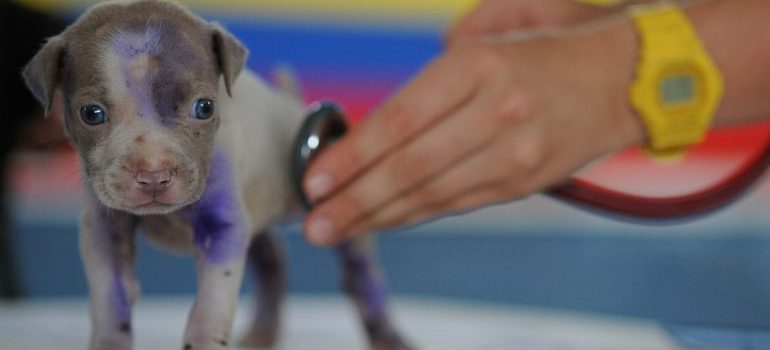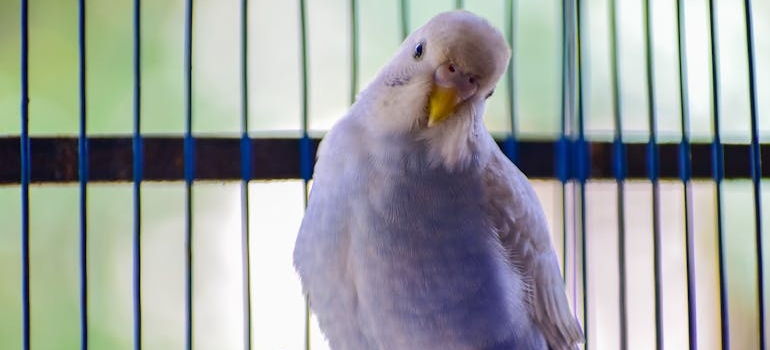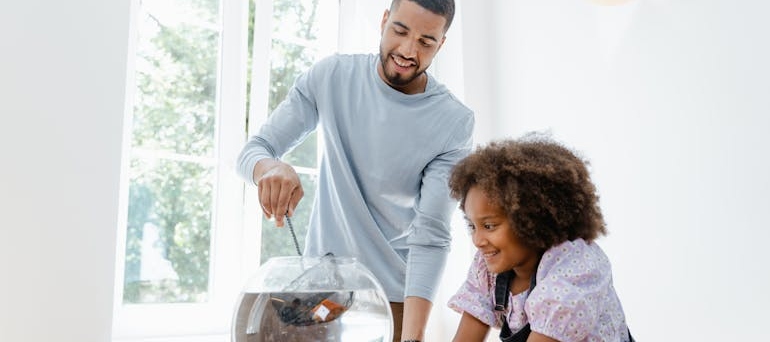Moving With Pets – How Best to Prepare
Moving is a significant event for every member of the family, and naturally, you want your pets to share in this new beginning with comfort and safety. Relocating can be as unsettling for our pets as it is for us, if not more. Pets can feel the shift in their environment deeply, picking up on both the excitement and stress that moving entails. This comprehensive Peasley Moving & Storage guide is designed to help you manage the complexities of moving with pets. Regardless of whether you have a playful pup, a curious cat, or a feathered friend, you’ll find tailored advice to address their specific needs, ensuring they stay calm and secure throughout the entire moving process.
Detailed Preparation Steps
Thorough preparation is the cornerstone of a smooth transition when moving with pets. Taking the time to address each detail ensures your pet’s safety and comfort and significantly reduces their anxiety in new environments. Whether you’re relocating nearby or across the country, early planning facilitates a seamless adjustment for your pets and peace of mind for you.
Early Vet Check-ups and Documentation
Start with a comprehensive visit to your veterinarian, which is vital for your pet’s travel readiness. This proactive step ensures that all vaccinations are up-to-date, health certifications are obtained, and any concerns about your pet’s ability to travel are addressed. Discuss options for anxiety management as it can also make the journey more comfortable for them.
Crate Training and Acclimatization
Transform the travel crate into a safe haven for your pet by introducing it into their routine well before moving day. Place it in a familiar area and encourage your pet to explore and spend time inside voluntarily. Gradually increase the duration they spend in the crate with positive reinforcements like treats and their favorite toys. Familiarity will help the crate become a source of comfort during the upheaval of moving.
Preparing a Pet-Friendly Travel Kit
A meticulously packed travel kit is essential to ensure your pet has everything it needs on a moving day. The kit should include necessities such as food, water, toys, and medication, all arranged to be easily accessible during the move. If you prepare this kit, you provide a sense of continuity and security for your pet amidst the changes, ensuring they feel cared for and reassured even when their environment is in flux.

Early Vet Check-ups and Documentation
As you prepare to move with pets while moving services Boise ID transfer your belongins, one of the first and most crucial steps is scheduling a comprehensive check-up with your veterinarian. This visit isn’t just about ticking a box—it’s about safeguarding your pet’s health against the stress of moving.
Health Check and Vaccination Update
Begin the visit with a thorough health examination to confirm your pet is fit for travel. Updating vaccinations is crucial, especially if your relocation involves moving to a different state or country with specific entry requirements for pets. Make sure to discuss your upcoming travel plans with the vet so they can provide any necessary certificates or records.
Managing Travel Anxiety When Moving With Pets
It’s common for pets to feel anxious about moving. Talk to your vet about your pet’s past experiences and any signs of anxiety they may exhibit. Your vet can offer solutions ranging from prescription medications to natural remedies like pheromone diffusers. These can play a critical role in keeping your pet calm and making the journey less stressful for them.
Securing Necessary Documentation
Always ensure all paperwork, including health certificates and travel documents, are in order. This is essential not only for compliance with regulations but also for easing your way through any checkpoints or travel barriers you might encounter during the move. Are you worried about how your pet will handle the journey? Discuss these concerns during your vet visit to tailor a plan that suits your pet’s specific needs, enhancing their comfort and your peace of mind.
Crate Training and Acclimatization
Pet crate acclimatization goes hand in hand with crate training. It should start as soon as you book your long-distance movers in Boise. It focuses on making your pet comfortable with its crate before the move. This process is essential to ensure that the crate feels like a safe haven during transit.
- Introducing the Crate: Start by placing the crate in an area where your pet spends a lot of time to spark their curiosity without overwhelming them. Keep the door open and place their favorite blanket or toys inside to make it inviting.
- Creating Positive Associations: Gradually encourage your pet to eat meals inside the crate and spend short periods locked in, increasing the duration as they become more comfortable. Utilize treats and praise to reinforce positive feelings about the crate.
- Practice Makes Perfect: Implement crate training pets for moving sessions by having your pet spend time in the crate during increasingly longer intervals. Start with quiet moments at home and then progress to short car rides.
Are you still wondering how to make crate training a stress-free experience for both you and your pet? Focus on gradual acclimatization and always associate the crate with positive experiences.

Preparing a Pet-Friendly Travel Kit
Creating a travel kit for your pet that caters to both their needs and comforts is important for a smooth transition. Let’s explore some innovative ideas to boost your pet’s travel experience:
- Kit Contents: Your pet’s travel kit should include food, water, bowls, favorite toys, and any necessary medications. Include a familiar blanket or a piece of clothing with your scent to comfort them. Also, pack a first-aid kit tailored for pets, including items like bandages, antiseptic, and tweezers for any unexpected situations.
- Accessibility: Obtain packing supplies Boise offers on time and pack these items in a bag that’s easily accessible during the move. This ensures you can quickly reach anything your pet needs without having to unpack other boxes or luggage.
- Smart Pet Gear: Include a smart water bottle that allows pets to hydrate on demand without spillage, and consider a GPS tracker collar to monitor your pet’s location throughout the journey, providing an extra layer of security.
- Comfort and Calm: When moving with pets, it is key to integrate calming aids into your travel kit. A scented collar or a calming spray that mimics pheromones can significantly reduce travel-induced anxiety. Also, pack a collapsible pet bed or a portable hideaway that fits in the travel crate, offering your pet a snug spot to retreat.
- Feeding Solutions: Pack collapsible food and water dishes for easy storage and accessibility. Include portioned, vacuum-sealed pet food to maintain freshness and minimize space.
- Health and Hygiene: For longer journeys, include disposable litter trays for cats or portable potty pads for dogs, which help manage hygiene without frequent stops. Also, consider packing pet-safe wipes and a grooming brush to keep your pet clean and comfortable.
- Special Considerations: If you’re traveling by air, check with the airline for specific pet travel guidelines. This might affect how you pack your travel kit, particularly with regard to container size and allowable contents.
Finally, to make the journey even smoother, try introducing your pet to these travel accessories several days before the move so they can get accustomed to them in a familiar environment.
Specific Tips for Different Pet Types
Moving with pets involves careful consideration of each animal’s specific needs to ensure their comfort and safety. Here’s a detailed guide to help you prepare different types of pets for the move.
Dogs
Dogs often perceive moving as a big adventure but can also feel the stress of change. Start preparing by acclimating your dog to their travel crate well before the move. This can be done by placing their favorite blanket inside the crate and using positive reinforcement during crate time.
For travel, secure the crate in the vehicle or use a dog seatbelt harness to keep them safe. During the trip, plan for regular stops—every two to three hours—to let them stretch, relieve themselves, and drink water. To help them adjust quickly at the new home, set up a familiar sleeping area and maintain their regular feeding and walking schedule.

Cats
Cats are creatures of habit and can be particularly sensitive to moving. Ensure they travel in a sturdy carrier that allows them to stand, turn around, and lie down comfortably. Line the carrier with a familiar-smelling blanket or pad to provide comfort. Introduce your cat to the carrier well in advance of the move by leaving it open in their favorite area.
It encourages exploration and relaxation inside it with treats and favorite toys. On moving day, keep the environment as quiet as possible and consider using a pheromone spray to reduce stress. Once at the new home, confine your cat to one room initially until they seem comfortable to explore more.
Birds
Transporting birds requires a stable environment while you’re moving to Idaho to prevent injury. Use a sturdy travel cage that covers it to reduce stress from environmental changes. The cage should include familiar perches and toys. Maintain a comfortable temperature in the vehicle, especially avoiding extreme cold or heat, as birds are sensitive to temperature changes. Offer food and water during stops, but avoid overfeeding before travel to prevent sickness.
Small Mammals
Small mammals like rabbits and hamsters should be moved in secure, well-ventilated, and comfortable travel cages. Because these animals can be skittish, minimize exposure to loud noises and large, open spaces. Change bedding frequently to keep the travel cage clean and dry. If possible, transport them in a part of your vehicle that maintains a steady temperature to avoid overheating or chilling, which can be fatal.
Reptiles
Reptiles require careful attention to temperature and security during moves. Use an appropriate-sized travel terrarium with secure lids to prevent escapes. Maintain temperature using portable heaters or ice packs, as needed, to replicate their regular environment. Avoid feeding reptiles for 1-2 days before the move to prevent health issues during travel. Once at your destination, set up their habitat first to stabilize their environment quickly.
Fish
Moving fish can be particularly challenging due to their sensitivity to changes in their environment. It’s crucial to minimize stress by keeping the travel time as short as possible. To maintain water quality, transport fish in large, sturdy bags filled with their old tank water. Secure the bags in a dark, temperature-stable container.

Choosing the Right Transportation
Selecting the appropriate mode of transportation for your pet is crucial for their comfort and safety. It is important to explore the best options and tips for each travel scenario:
- Car Travel: For many, traveling by car is the most practical option. Prepare a secure space for your pet with a safety harness or a secured crate. Make frequent stops to allow your pet to stretch and relieve themselves. Keep the car well-ventilated and avoid feeding your pet just before the trip to prevent motion sickness.
- Air Travel: If air travel is necessary, choose a pet-friendly airline and understand their specific requirements well in advance. Book direct flights to minimize stress on your pet, and ensure their travel crate is airline-approved.
- Public Transportation: If you’re using trains or buses, check the pet policies of Seattle service providers. Some allow pets if they are kept in a carrier. Always keep a portable water dish accessible and ensure your pet remains calm and quiet throughout the journey.
Are you unsure about the best travel option for your pet? Consider their comfort with different travel modes and consult your vet to determine the safest and most comfortable choice.
Patience and Care: Key to Pets Adapting to a New Home
Moving with pets is a significant responsibility—one that requires careful planning and consideration. The environment on moving day can be chaotic, so it’s crucial to keep pets in a calm area away from the hustle and bustle until it’s time to travel. Upon arrival at your new home, while your items are still in storage units Boise Idaho offers, immediately set up a familiar space for your pets with their favorite toys and bedding, which can ease their transition and help them settle more quickly.

